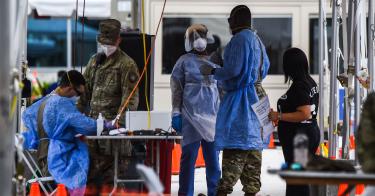Problems with testing plagued the early response to the COVID-19 pandemic in America, but the states and the country have made tremendous strides in ensuring Americans can get tested if they feel the need to get tested. But there’s a catch.
After it was clear that America needed mass testing, the Food and Drug Administration began issuing numerous emergency use authorizations to private and university labs across the country to begin COVID-19 testing. In the past few days, the country has collected more than 700,000 test daily.
The catch? It may take a week or more to get back the results.
Recently I was talking to a colleague who is over 65—and thus at higher risk of serious effects from COVID-19—and he mentioned how he was referred by the local health department to CVS for a COVID-19 test. Although the test sample was collected quickly enough, he was told to expect a result in five days.
This is an unacceptable delay if we want to properly fight this pandemic. It must be corrected now—and in time for the next potential wave of cases.
This is not a unique story. Unacceptably long delays in test results have occurred in Virginia, where my colleague lives, in New Jersey, Louisiana, Florida, California, and other states. Quest Diagnostics, one of the largest labs in the country, confirmed the as much in a press release stating, while priority tests for hospitalized or pre-op patients are being turned around in about a day, everyone else is experiencing about a weeklong turnaround.
This is a problem because the time from when a person first starts experiencing symptoms to then needing to be admitted to the hospital can be 5 days. A person requiring admission to the intensive care unit may occur shortly thereafter, and mortality of those admitted to the ICU may range from 39 percent to 72 percent. These risks are higher for those over 65.
Without knowing one’s own COVID-19 status, whether positive or negative, every cough, deep breath, or pang of fatigue can be an ominous sign of imminent deterioration—or a harmless reflex. With such a potentially deadly disease for high-risk persons, it is vital that those who test positive receive medical attention, but that is impossible with a backlog of tests.
The problem seems to be a shortage of the components needed to conduct the tests. A July 8 letter to Vice President Pence signed by several laboratory and testing associations, pointed to a lack of test kits, appropriate swabs, and transport media for collected samples, as well as a shortage of the necessary reagents to conduct the tests.
The fact that there are shortages of such components while America continues to break testing records each day shows that the demand for these tests is outstripping the rapidly growing supply of them. The increased demand is likely the result the recent surge in new COVID-19 cases that has resulted in more new confirmed cases daily than at any point of the pandemic.
This may explain the delays, but it certainly doesn’t excuse them. In fact, the recent surge presages the nation’s response to the expected “second wave” of COVID-19 cases in the Fall. Prompt and broadly available testing is absolutely necessary for us to keep abreast of the virus and have any chance of suppressing it.
Simply put, this was a trial—and we’re failing.
Per the letter to the Vice President, increased transparency in the procurement process might be a good place to start. That way, labs can communicate with the task force and the public can hold it accountable, because according to complaints in the letter, it is unclear who the point of contact is to resolve these problems in the testing supply chain.
While some of the components and supplies are only available through the Centers for Disease Control and Prevention’s International Reagent Resource, many appear to be directly available from the manufacturers. It may be better for medical providers and labs to leverage existing distribution networks, rather than expecting the federal government to coordinate distribution.
In fact, it’s hard to imagine that a federal office could better coordinate distribution, given that they lack some key information. How many hospitals and universities can run tests? How many can they run? Who has what kind of tests? These are questions that need to be answered and made available, not just to medical providers and labs running the tests, but to individuals looking to get tested.
State and local governments are actually better able to assess what capacities, capabilities, and quantities of test components exist in their jurisdictions. Gathering and disseminating that information will help physicians, hospitals, and labs make supply chain decisions and help individuals find available tests with the shortest waits.
In short, governments should be in the business of coordinating information for the public and medical providers to use, rather than attempting to coordinate the physical distribution of products—which apparently hasn’t been helped by recent increased federal involvement in the supply chain.
We are months into the pandemic response, but this recent experience tells us we are not yet prepared to provide enough testing to handle a spike in cases. Manufacturers continue ramping up production to meet demand.
But while supply is still trying to catch up, state and local public health agencies need to do a better job of gathering and disseminating information on local needs, capabilities and supplies in order to help medical providers, labs and patients make more informed decisions.
This piece originally appeared in RealClear Health



